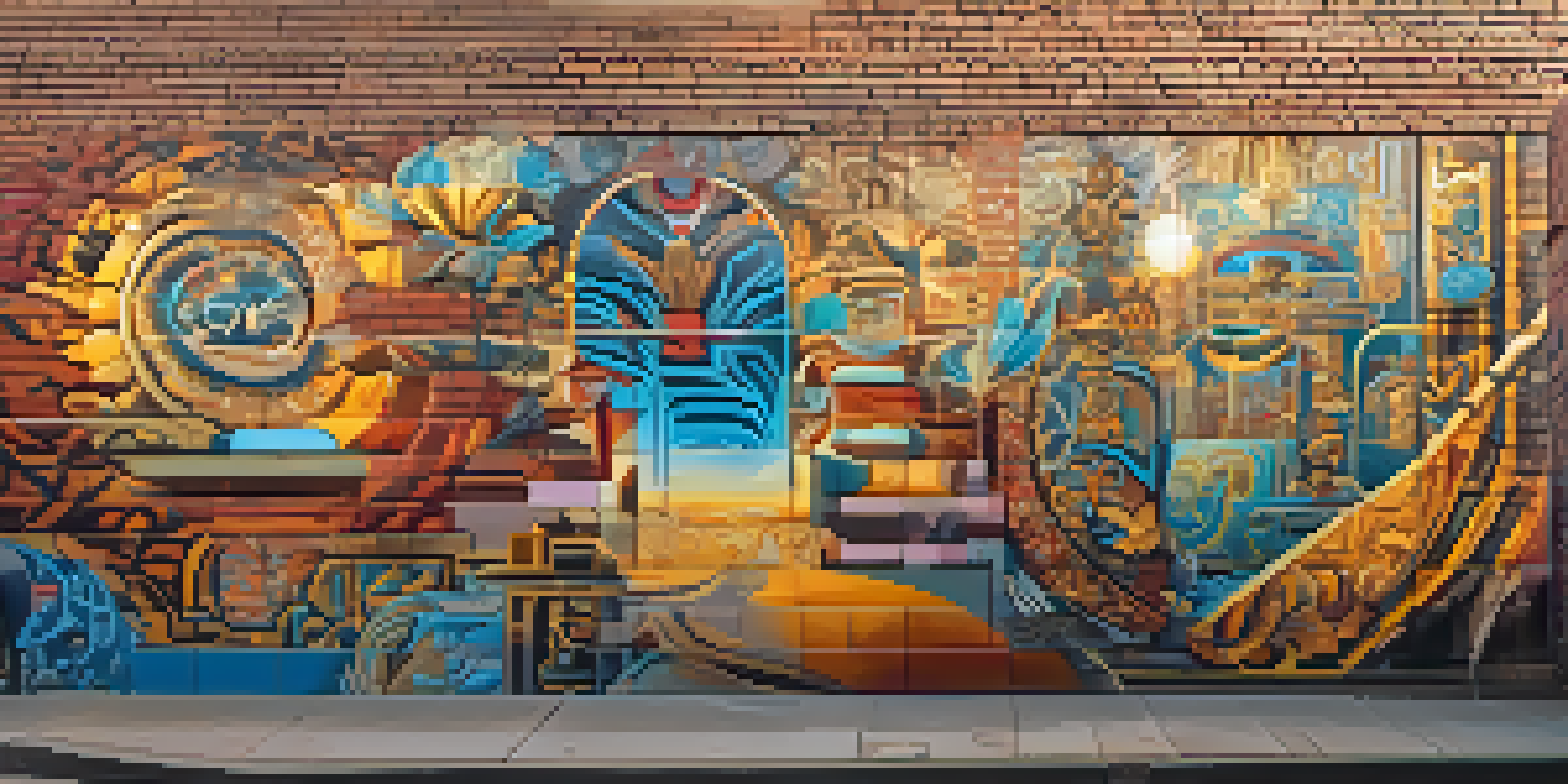The Impact of Globalization on Contemporary Art Practices

Understanding Globalization and Its Role in Art
Globalization refers to the interconnectedness of cultures, economies, and ideas across the globe. In the context of art, it means that artists now have access to a wider range of influences and resources than ever before. This blending of cultures can lead to innovative and unique artistic expressions that reflect a global narrative.
Art is a universal language that transcends cultural boundaries, allowing people to connect and understand each other in profound ways.
As artists draw inspiration from various cultural backgrounds, they often create works that resonate on a universal level. For instance, a contemporary piece may incorporate traditional motifs from one culture while utilizing modern techniques from another. This fusion not only enriches the artwork but also encourages dialogue between diverse communities.
Moreover, globalization allows for the exchange of ideas and techniques through international exhibitions and art fairs. Artists can collaborate and share their experiences, leading to a more dynamic art scene that transcends geographical boundaries.
The Rise of Digital Platforms in Art Distribution
Digital platforms have revolutionized the way art is created, shared, and sold, breaking down barriers that once limited exposure to local audiences. Artists can now showcase their work on social media, online galleries, and auction sites, reaching potential buyers and fans worldwide. This democratization of art distribution empowers creators and allows them to connect with audiences directly.

For example, platforms like Instagram have become essential tools for artists to build their brand and showcase their portfolios. A painter in a remote village can gain recognition through their online presence, attracting collectors from major cities across the globe. This shift not only amplifies diverse voices in the art world but also challenges traditional art market norms.
Globalization Enhances Artistic Diversity
Globalization allows artists to draw from a broader range of cultural influences, resulting in innovative and unique artistic expressions.
However, this digital shift also raises questions about authenticity and commercialization. As art becomes more accessible online, artists must navigate the balance between maintaining their unique vision and appealing to a broader audience.
Cultural Appropriation vs. Cultural Appreciation
One of the most significant discussions in contemporary art is the fine line between cultural appropriation and cultural appreciation. With globalization, artists often draw from a variety of cultural sources, but this can lead to controversy when elements are used without proper understanding or respect. Cultural appropriation occurs when aspects of a culture are taken out of context and used in a way that diminishes their significance.
The role of the artist is to make the revolution irresistible.
On the other hand, cultural appreciation involves a respectful and informed engagement with another culture, often acknowledging its origins and significance. Artists who engage in this way can create meaningful and enriching works that foster cross-cultural dialogue. For example, a Western artist collaborating with Indigenous artisans can celebrate and honor traditional practices while creating something new.
Navigating this complex terrain requires sensitivity and awareness from artists. Engaging with diverse cultures thoughtfully can lead to powerful art that not only resonates with a global audience but also honors the cultures it draws from.
Globalization's Effect on Art Movements and Trends
Globalization has given rise to new art movements that reflect the complexities of a connected world. Movements such as transnationalism and post-colonialism challenge traditional narratives and highlight the experiences of marginalized voices. Artists in these movements often address themes of identity, migration, and globalization itself, making their work incredibly relevant in today's context.
For instance, the rise of street art as a global phenomenon illustrates how local voices can gain international recognition. Artists like Banksy have transcended borders, using public spaces to comment on social issues that resonate on a global scale. This accessibility of art in everyday spaces allows for a more inclusive dialogue about contemporary issues.
Digital Platforms Transform Art Market
Digital platforms empower artists by providing direct access to global audiences, challenging traditional art distribution methods.
As these movements evolve, they reflect the changing nature of society. Art becomes a platform for critical conversations about race, gender, and politics, showcasing how globalization influences not just the art itself but the very conversations surrounding it.
Economic Implications of Globalized Art Markets
The globalization of art has significant economic implications for artists and art markets alike. As art becomes a global commodity, it opens new avenues for sale and promotion, but it also creates challenges in terms of competition and pricing. Emerging artists must navigate a market saturated with diverse voices, which can be both a blessing and a curse.
Art fairs and international exhibitions have become crucial for artists seeking to break into the global market. These events provide opportunities for exposure and sales, but they often come with hefty participation fees that can be prohibitive for independent artists. As a result, the economic landscape can favor established artists with resources while leaving emerging talents struggling to gain traction.
Additionally, the rise of online sales platforms has created a shift in how art is valued and sold. While this democratizes access to art, it also raises questions about the future of traditional galleries and the role they play in supporting artists. Understanding these economic dynamics is essential for artists looking to thrive in a globalized art world.
The Role of Social Media in Shaping Art Narratives
Social media has become a powerful tool for artists to shape their narratives and engage with audiences. Platforms like Twitter, TikTok, and Facebook allow artists to share their processes, thoughts, and inspirations directly with followers, creating a personal connection that was previously difficult to establish. This immediacy contributes to a more intimate understanding of the artist's journey.
Moreover, social media facilitates the rapid dissemination of art trends and movements. A single post can spark global conversations and inspire other artists, leading to a dynamic exchange of ideas. For instance, viral challenges can encourage artists to experiment with new styles or themes, reflecting the diverse influences of a global audience.
Navigating Cultural Sensitivity in Art
Artists must balance cultural appropriation and appreciation, ensuring respectful engagement with diverse cultural influences in their work.
However, the reliance on social media also presents challenges. Artists may feel pressure to conform to popular trends or produce content that garners likes and shares, potentially compromising their artistic integrity. Balancing authenticity with the demands of the digital age is a crucial consideration for contemporary artists.
Future Directions: Art in a Globalized World
As globalization continues to shape contemporary art, the future holds exciting possibilities for artistic expression. Artists are increasingly exploring themes of connectivity, identity, and social justice, reflecting the dynamic interplay of cultures. This evolution suggests that art will continue to serve as a mirror to society, addressing pressing issues in innovative ways.
The growing emphasis on sustainability within the art world also signals a shift towards more conscious practices. Artists are becoming more aware of their environmental impact and are seeking ways to incorporate sustainable materials and methods into their work. This commitment to sustainability aligns with broader global movements advocating for environmental responsibility.

Ultimately, the impact of globalization on contemporary art practices is a multifaceted and evolving dialogue. As artists navigate this landscape, they will continue to challenge conventions, foster connections, and create works that resonate with a diverse and interconnected world.